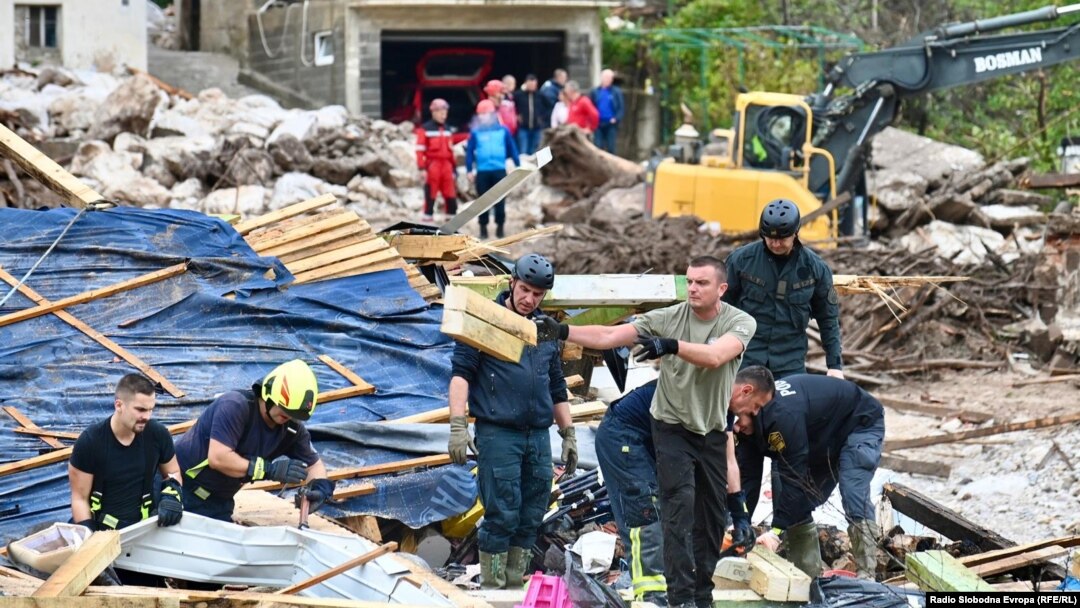Rescue teams are searching for up to 40 people still missing following deadly flash-flooding in Bosnia-Herzegovina that has left some villages completely cut off and prompted officials to declare a state of disaster.
At least 18 people were killed after heavy rainstorms early on October 4 triggered floods and landslides in central and southern areas of the Balkan country.
RFE/RL's Balkan Service is covering developments on its live blog.
Fifteen of the deaths were in Herzegovina and three in Bosnia, and bridges and roads were destroyed in both entities, hampering rescue workers.
Your browser doesn’t support HTML5
Deadly Floods Hit Bosnia Following Heavy Rain
On October 5, Bosnian authorities said the two latest fatalities were discovered in the area of Donja Jablanica, a village of some 450 people near the hard-hit municipality Jablanica.
The Civil Protection Service has estimated that between 20 and 40 people are missing.
Cleanup efforts began on October 5 in Jablanica, where 12 deaths were reported, and neighboring Konjic, where one person died.
The two municipalities are located halfway between the southern city of Mostar and the capital, Sarajevo.
The sudden rains hit as many residents were sleeping, and water rose over the roofs of houses and left entire villages buried in mud. Crews in Jablanica were working to remove piles of rocks and debris as the floodwaters subsided.
The municipality, a major tourist destination situated along the Neretva River and Jablanica Lake in the Herzegovina-Neretva Canton, was devastated by flooding. Roads and railway links have been destroyed, cutting off the area. In the village of Donja Jablanica, rocks from a nearby quarry reportedly buried homes.
Homes in the village of Donja Jablanica damaged by landslides.
Six people have been reported missing in the Jablanica area and four in Konjic.
The three remaining deaths were recorded in Fojnica in central Bosnia, the Civil Protection Service told RFE/RL.
Early reports had put the death toll at 19, but this was reduced after authorities in Herzegovina clarified that some victims had been counted twice.
Darko Jukan, spokesman for the authorities in Herzegovina-Neretva Canton, said on October 4 that "in some cases only parts of roofs can be seen.”
“I cannot remember a crisis of such a magnitude since the [1992-95] war," he said.
Emir Begovic, a resident of Donja Jablanica, told RFE/RL that "when we saw the storm coming we expected this…Water came through the front door, the door immediately broke and [water] "pushed" us into one of the bedrooms."
"My wife, child, and I -- we had our granddaughter [with us] -- we were waiting, wondering if we should we escape [from the house]. Water flowed like two rivers above the house."
Anel Steta, a volunteer worker from Mostar, said the situation in the Jablanica region was "catastrophic."
"The mud does not allow us to work," he told RFE/RL.
"The conditions are difficult. One lifeless body was found. Unknown person, unknown identity...it is disastrous," he added.
Bosnian media footage taken from drones showed villages and towns completely covered by water, while videos on social networks showed muddy torrents and damaged roads. On October 5, locals and emergency workers attempted to divert flood waters that had blocked access to villages.
Flash floods caused by heavy rains were also reported in Montenegro, south of Bosnia, while in Croatia strong winds and torrential rains closed several roads.


